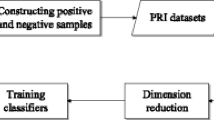Abstract
Negative examples in automated protein function prediction (AFP), that is proteins known not to possess a given protein function, are usually not directly stored in public proteome and genome databases, such as the Gene Ontology database. Nevertheless, most computational methods need negative examples to infer new predictions. A variety of algorithms has been proposed in AFP for negative selection, ranging from network- and feature-based heuristics, to hierarchy-based and hierarchy-less strategies. Moreover, several bio-molecular information sources about proteins, such as gene co-expression, genetic and protein-protein interactions data, are naturally encoded in protein networks, where nodes are proteins and edges connect proteins sharing common characteristics. Although selecting negatives in biological networks is thereby a central and challenging problem in computational biology, detecting the characteristics proteins should have to be considered as negative is still a difficult task. It this work, we show that a few protein features extracted from the network help in detecting reliable negatives. We tested such features in two real world experiments: predicting unreliable negatives with an SVM classifier through temporal holdout on model organisms for AFP, and selecting reliable negatives with a clustering-based state-of-the-art negative selection procedure.
Access this chapter
Tax calculation will be finalised at checkout
Purchases are for personal use only
Similar content being viewed by others
Notes
References
Robinson, P.N., et al.: The human phenotype ontology: a tool for annotating and analyzing human hereditary disease. Am. J. Hum. Genet. 83(5), 610–615 (2008)
Ruepp, A., et al.: The FunCat, a functional annotation scheme for systematic classification of proteins from whole genomes. Nucleic Acids Res. 32(18), 5539–5545 (2004)
Ashburner, M., et al.: Gene ontology: tool for the unification of biology. Nature Genet. 25(1), 25–29 (2000)
Radivojac, P., et al.: A large-scale evaluation of computational protein function prediction. Nat. Methods 10(3), 221–227 (2013)
Jiang, Y., Oron, T.R., et al.: An expanded evaluation of protein function prediction methods shows an improvement in accuracy. Genome Biol. 17(1), 184 (2016)
Mordelet, F., Vert, J.P.: A bagging SVM to learn from positive and unlabeled examples. Pattern Recogn. Lett. 37, 201–209 (2014)
Burghouts, G.J., Schutte, K., Bouma, H., den Hollander, R.J.M.: Selection of negative samples and two-stage combination of multiple features for action detection in thousands of videos. Mach. Vis. Appl. 25(1), 85–98 (2014)
Frasca, M., Malchiodi, D.: Selection of negative examples for node label prediction through fuzzy clustering techniques. In: Bassis, S., Esposito, A., Morabito, F.C., Pasero, E. (eds.) Advances in Neural Networks. SIST, vol. 54, pp. 67–76. Springer, Cham (2016). doi:10.1007/978-3-319-33747-0_7
Gomez, S.M., Noble, W.S., Rzhetsky, A.: Learning to predict protein-protein interactions from protein sequences. Bioinformatics 19(15), 1875–1881 (2003)
Mostafavi, S., Morris, Q.: Using the gene ontology hierarchy when predicting gene function. In: Proceedings of the Twenty-Fifth Conference on Uncertainty in Artificial Intelligence, pp. 419–427 (2009)
Youngs, N., Penfold-Brown, D., Drew, K., Shasha, D., Bonneau, R.: Parametric bayesian priors and better choice of negative examples improve protein function prediction. Bioinformatics 29(9), tt10-98 (2013)
Youngs, N., Penfold-Brown, D., Bonneau, R., Shasha, D.: Negative example selection for protein function prediction: the NoGO database. PLOS Comput. Biol. 10(6), 1–12 (2014)
Frasca, M., Bassis, S.: Gene-disease prioritization through cost-sensitive graph-based methodologies. In: Ortuño, F., Rojas, I. (eds.) IWBBIO 2016. LNCS, vol. 9656, pp. 739–751. Springer, Heidelberg (2016). doi:10.1007/978-3-319-31744-1_64
Ashburn, T.T., Thor, K.B.: Drug repositioning: identifying and developing new uses for existing drugs. Nat. Rev. Drug Discov. 3(8), 673–683 (2004)
Gillis, J., Pavlidis, P.: The impact of multifunctional genes on “Guilt by Association” analysis. PLoS ONE 6(2), e17258 (2011)
Frasca, M.: Automated gene function prediction through gene multifunctionality in biological networks. Neurocomputing 162, 48–56 (2015)
Opsahl, T., Agneessens, F., Skvoretz, J.: Node centrality in weighted networks: generalizing degree and shortest paths. Soc. Netw. 32(3), 245–251 (2010)
Frasca, M., Bertoni, A., et al.: UNIPred: unbalance-aware Network Integration and Prediction of protein functions. J. Comput. Biol. 22(12), 1057–1074 (2015)
Szklarczyk, D., et al.: String v10: proteinprotein interaction networks, integrated over the tree of life. Nucleic Acids Res. 43(D1), D447–D452 (2015)
Cortes, C., Vapnik, V.: Support-vector networks. Mach. Learn. 20, 273–297 (1995)
Mostafavi, S., Goldenberg, A., Morris, Q.: Labeling nodes using three degrees of propagation. PLoS ONE 7(12), e51947 (2012)
Author information
Authors and Affiliations
Corresponding author
Editor information
Editors and Affiliations
Rights and permissions
Copyright information
© 2017 Springer International Publishing AG
About this paper
Cite this paper
Frasca, M., Lipreri, F., Malchiodi, D. (2017). Analysis of Informative Features for Negative Selection in Protein Function Prediction. In: Rojas, I., Ortuño, F. (eds) Bioinformatics and Biomedical Engineering. IWBBIO 2017. Lecture Notes in Computer Science(), vol 10209. Springer, Cham. https://doi.org/10.1007/978-3-319-56154-7_25
Download citation
DOI: https://doi.org/10.1007/978-3-319-56154-7_25
Published:
Publisher Name: Springer, Cham
Print ISBN: 978-3-319-56153-0
Online ISBN: 978-3-319-56154-7
eBook Packages: Computer ScienceComputer Science (R0)




